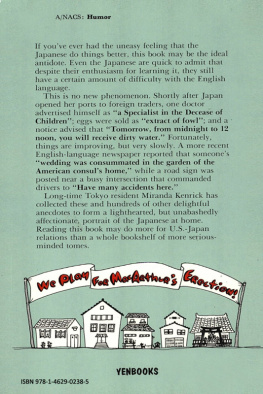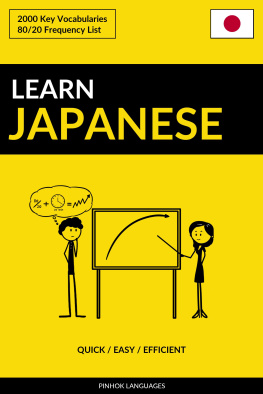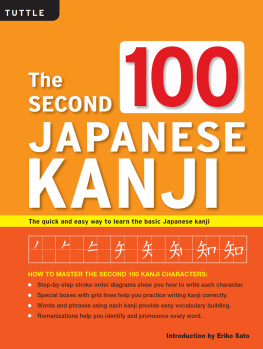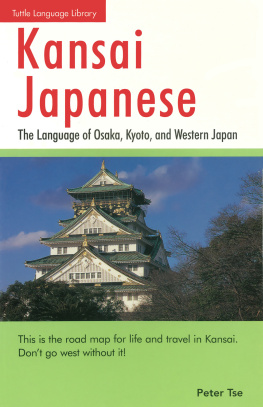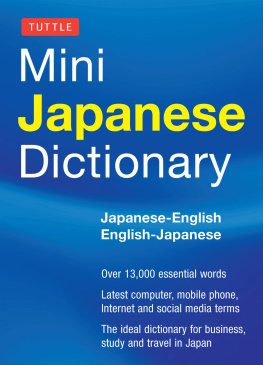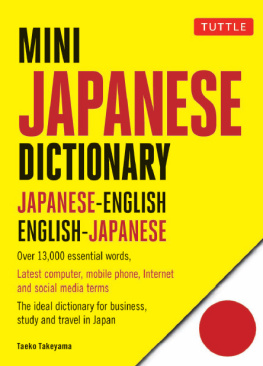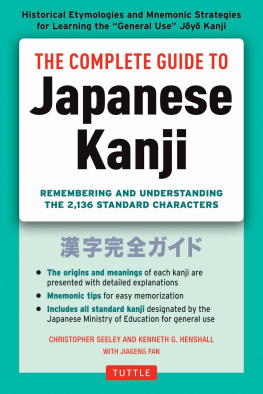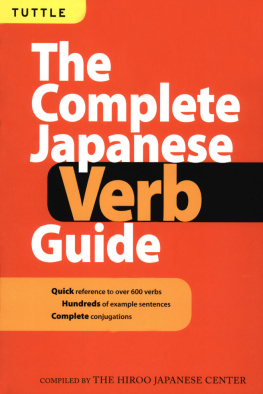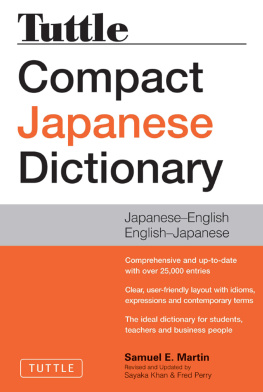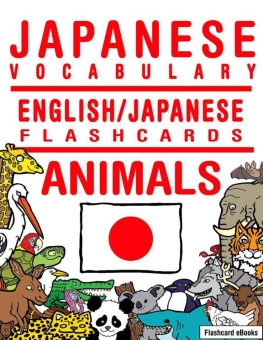GRATEFUL ACKNOLEDMENTis made to the Tokyo Weekender, which published the series of articles on which this book is based.
Many friends and acquaintances have contributed to the book. Strangers, too, having read the stories in the Weekender, have sent me their favorite examples of Japanized English. There are too many to name individually, but I should like to thank in particular Anthony Willoughby, for his help; Barbara Knode and Walter Nichols, who lent me their own archives; Don Maloney, for his kindness in writing the Foreword; and Corky Alexander, editor and publisher of the Tokyo Weekender.
The illustrations appearing on page 16 and various other examples of interesting usages of English are reproduced from the section entitled "English as she is Japped," in : Things Japanese, by Basil Hall Chamberlain, reprinted as Japanese Things, 1971, by Charles E. Tuttle Co., Inc.
The author would also like to express her indebtedness to the many people, published materials, and numerous examples of printed matter that helped to contribute to and make possible this book.
Foreword
IT WAS AROUND NOON one Sunday that I was in line at the American Club's buffet brunch table. I did that particular brunch almost every Sunday during the years my wife, Sarah, and I lived in Japan, not so much because everything laid out there tasted good (it did), but more because it looked goodbetter than anything I was likely to see while working around the local countryside during the coming week.
You know what I mean, I'm sure. Nothing spread on that buffet table was moving, and all the vegetables were near the same familiar colors I remembered from back in Cleveland. And the American Club's soups were always either cloudy or clear, never half and half like native varieties.
Anyway, on the particular Sunday I'm talking about, I was lined up behind two just-off-the-plane newcomers who were comparing problems that they had dealt withor thought they had dealt with during the previous week in Tokyo. "There's no two ways about it," one of them decided. "The problem here is the language."
When I heard that observation, I was positive they had just arrived. If they had been in Japan more than seven days, they would have known that there are two ways about it, and that's why language is definitely the problem.
Actually, there are four ways about the problem. That's because there are two languages involved Japanese and English. There are also, in turn, two Japanese languages. There's the one the Japanese speak, and then there's the one those of us foreigners who have taken Japanese lessons speak.
Same goes for English. There's the English we foreigners speak, and there's the English the Japanese speak. Really, it can get even more complicated than that, because only the Englishas only they could really mastered English. And the only people who really ever understand foreigner's Japanese are other foreigners who went to the same Japanese-language school.
Visitors to Japan get trapped very often because they don't really understand their own native language. For instance, I've seen Americans get more than somewhat upset with those girls who sit by the front doors in Tokyo department stores. They get mad because even though the girls wear big buttons that say "I Speak English," they don't seem to understand a word the visitors are saying. If that ever happens to you, please remember that the buttons say "I Speak English"they do not say "I Understand, English."
I bring that up because I want you to understand how all the Japanized English that Miranda Kenrick has collected came to be in the first place. It's all the product of those "I Speak English" people, a product that provides some of the best entertainment that the "I Understand English" people will ever find anywhere.
The only thing that might be more hilarious, in fact, would be if some of us "I Speak Japanese" folks started putting up Japanese signs back in Cleveland.
By the way, if some of you foreigners now living in Japan happen to understand exactly what the Japanese meant when they put together some of the gems in Miranda Kenrick's charming book, you really should consider going hometomorrow at the latest. Those who don't might retaliate with humor, like the foreigner who replied to "Is that 'L' as in Rome?" with "No, it's 'R' as in London."
But if you do decide to go home, take this little book with you. Nobody's going to believe you if they don't see it in print.
DON MALONEY
New York
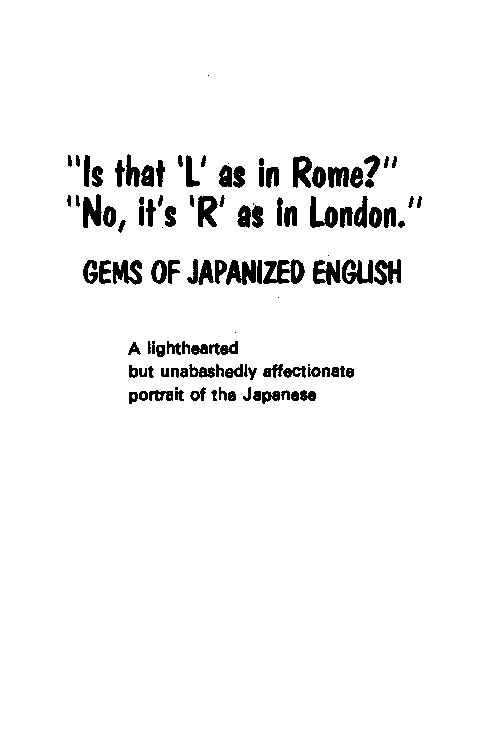


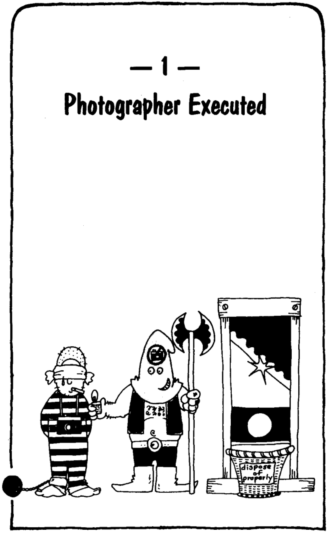
I HAVE LIVED in Tokyo all of my life, and have been amassing "howlers" for most of it. Fortunately for me, Japan is a country rich in examples, and the stunning errors that find their way into print provide constant and continuing entertainment.
Collecting "correctible" English is not a new hobby for Japanophiles. At the turn of the century, eminent British scholar, professor, and writer Basil Hall Chamberlain wrote Things Japanese, a glimpse into a new world, one which was then only recently opened to foreign trade and visitors. Chamberlain's introduction to Japan ranges from "Art" and "Abacus" through "History" and "Harakiri" to "Wood Engraving" and "Women." Tucked into the book is a chapter called "English as she is Japped," containing riveting examples of the written English that surrounded him in his life in Japan.
Stationery shops, for instance, offered "hand panting post cards," while clothes could be bought from a "Tailor Native Gountry" or a "Draper, Milliner, and Ladies Outfatter."
I wonder what confidence a doctor could have inspired when he proclaimed himself a "Specialist for the Decease of Children." Or a studio that offered "Photographer Executed."
Cosmetic counters are said to have displayed "Best Perfuming Water Anti Flea," while egg shops sold "extract of fowl" and dairies proudly paraded "pest milk." It was also possible, apparently, to buy not only "fresh laid eggs," but "fresh laid milk" too!
Who could have resisted these next choice items?
Fire shovels advertised themselves thus:
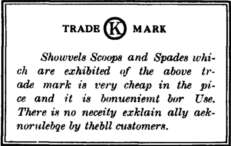
Chamberlain founder a beer bottle with a label making these modest claims:
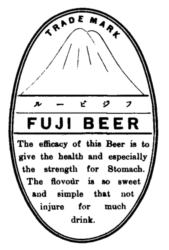
Just think of all the people whose lives must have been brightened by such promises, and who merrily drank themselves into oblivion, feeling that they were under the equivalent of doctor's orders.
As for "Fragrant Kozan Wine," its propaganda declared :
If health be not steady, heart is not active. Were heart active, the deeds must be done. Among the means to preserve health, the best way is to take in Kozan wine which is sold by us, because it is to assist digestion and increase blood. Those who want the steady health should drink Kozan wine. This wine is agreeable even to the females and children who can not drink any spirit because it is sweet. On other words, this pleases mouth and therefore, it is very convenient medicine for nourishing.

